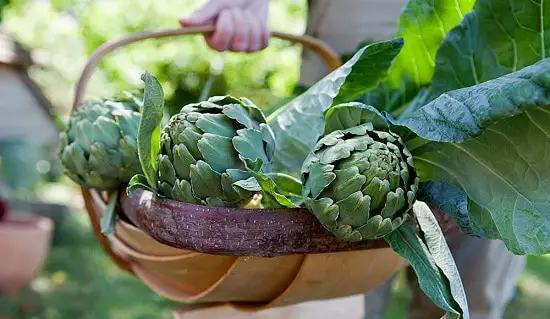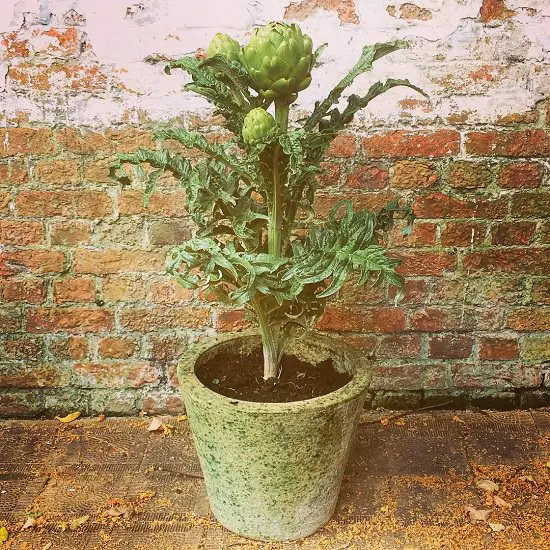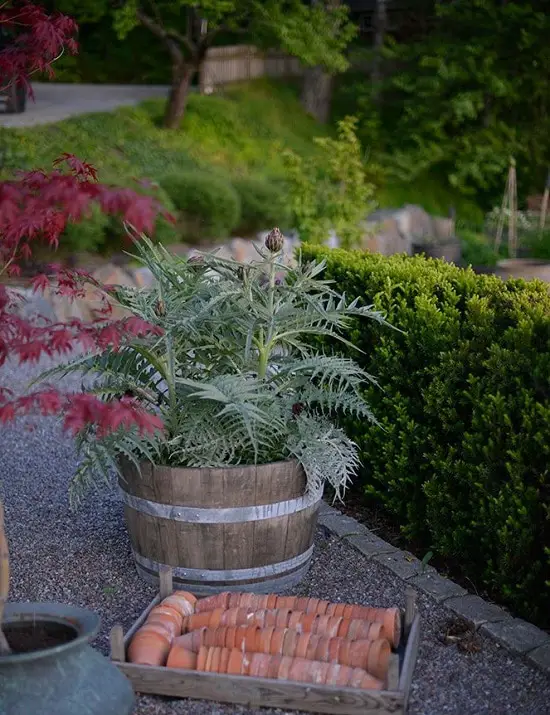Don’t have enough garden space? No worries! Growing Artichokes in Pots is possible and easy when you know how! Learn the process here!
In warm climates, Artichokes are short-living perennials, but in cold climates, they are grown as annuals. Chokes are delicious and packed with essential nutrients like Vitamin C, magnesium, potassium, dietary fibers. If you don’t have a garden area, you can grow them in a small space as well! Continue reading to learn about Growing Artichokes in Pots.
Botanical Name: Cynara scolymus
Common Names: French artichoke, Green artichoke
Check out our article on growing Wasabi in Pots here!
What is Artichoke?

Artichokes belong to the Asteraceae family of plants. They are big thistles grown for edible flower buds and harvested before flowering. The buds are overlapped with spiny green bracts surrounding the actual flower. The base is tender and flavorful. Artichoke ‘heart’ is cooked and served in dishes.
Artichoke Varieties
Globe Artichokes are round, measuring fat 4-5 inches in diameter. The popular varieties are Green Globe, Imperial Star, and Tempo.
Elongated Artichokes includes Violetto. It produces 3-4 inches wide and 5-6 inches long elongated artichoke.
Here is everything you need to know about growing Malabar Spinach in Pots!
Also Read: 15 Types of Artichokes
How to Grow Artichokes

Container Size
A 14-16 inches deep and wide container is going to be apt for growing these plants as their roots expand, and the plant produces about 26-44 artichokes per growing season. A wine barrel can also be an excellent choice to grow these plants!
- Mature plants can reach a height of 3-5 feet with a similar spread. If you are growing multiple plants together, keep them atleast 3 feet apart.
- If you’re growing artichokes as perennials, select much bigger pots.
Planting Time
In a hot climate (USDA Zones 9-11), you can plant artichokes in either spring or fall. If you are someone who is living in a colder climate, plant them in spring, For an early start, plant them eight weeks before the last predicted frost date indoors. In USDA zone 6 and below, they’re grown as annuals.
Planting Artichokes
You can grow them by seeds but artichokes grown from seeds usually flower from the second year of growth. You can also propagate artichoke from offshoots (pups) that grow around the established mother plant, this way they flower from the same year. Alternatively, you can also buy transplants from a garden center or online.
- While growing from seeds, soak them in lukewarm water overnight. Sow the seeds 1/4 inch (0.6 cm) deep the next day. Use a good quality seed mix. They will germinate in 10-14 days.
- Keep the soil moist, and never let it go dry. Once the seedlings have two sets of leaves and 8 inches tall, plant them in desired containers.
Want to grow Swiss chards in pots? Here’s all you need to know!
Requirements for Growing Artichokes in Pots

Location
Artichokes can withstand some shade, but that affects flower buds. Although they perform well in full sun, in hot regions, it’s better to keep the containers in the shade in the afternoon.
Soil
Use fertile, sandy-loamy, and well-draining soil with a pH 6-6.8. Fill the pot with a good quality potting mix combined with organic compost or an all-purpose granular fertilizer.
Water
Water artichoke regularly as the plant requires plenty of water to produce tender flower buds. Apply a thick layer of mulch to retain moisture of the soil as warm soil results in quick flowering.
Note: Keep in mind that container-grown artichokes tend to dry quickly as compared to chokes grown on the ground. Hence check the topsoil regularly in hot climates.
Temperature and Humidity
Artichokes perform well in warm and dry weather of California and Mediterranean regions. You can also grow them as perennial in other subtropical and tropical parts but do remember that excessive heat results in premature flowering. 50-77 F (10-25 C) is the perfect temperature range for growing these plants.
Here is how you can grow Turnips in pots easily!
Artichoke Care
Fertilizer
Fertilize the plant with a balanced liquid fertilizer, diluted at half or quarter-strength, once a month during the growth period. Feed the plant again when the first artichoke emerges. Water plants thoroughly before the application and avoid pouring near the leaves as they can burn. Alternatively, you can also feed fish emulsion to the plants every 8-10 weeks.
Overwintering
- Cut the plants all the way to the soil level.
- Make a pile of leaves and straws in the pot.
- In spring, when the temperature will rise, take the pot outside in the sun.
Note: Green Globe and Violet de Provence survive winters the best.
Pests and Diseases
In damp weather conditions, slugs can attack your artichokes. Mainly they feast on young, tender leaves. Aphids are one more threat, but they can be hosed off. Provide the plant sufficient space for air circulation.
Gray mold or botrytis can damage flower bracts and leaves by turning them brown and grey. Remove the affected leaves immediately after you notice the disease. Use a fungicide recommended for edible plants or try neem oil.
Harvesting and Storage
Harvesting mainly depends on the climate and the variety you are growing. The plants become ready to harvest in the second year after planting. You can snip the tender buds when they are the size of an apple. Artichokes can be stored in the refrigerator for a week. You can preserve the buds by cooking, pickled, or canned.
Cooking Artichokes
Artichokes can be served, roasted, or steamed. They taste best when cooked or sauteed lightly. You can enjoy them raw by serving them in salads as well.
Artichoke Health Benefits
- Artichokes are high in fibers, protein, vitamin C, B6 and K, thiamine, riboflavin, niacin, magnesium, potassium, and zinc.
- Helpful in reducing the levels of bad LDL Cholesterol.
- Being less in calories, they help in reducing body fat and weight.




Can seeds be removed from the mature flowers?
Can the seeds be eaten?
Pillow is I send a picture of my artichoke plant can you tell me if it’s right what it is is it I have the crown and I believe I may not has cut it down enough that the crown is there and the shoots are shooting out the sides not the middle of this town and this almost like little tiny but they’re just like little tiny artichoke plants grow from the side thank you help please